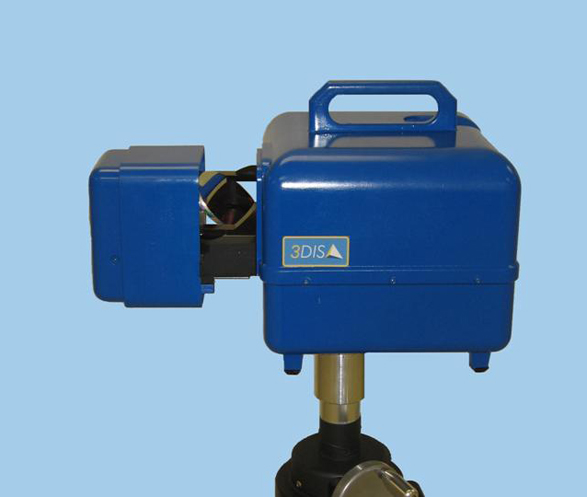Maximizing the US Navy’s readiness for battle means compressing the schedules for maintenance and modernization of the Navy’s fleet of ships. Late last summer we interviewed Robert L. Stout, Modernization Logistics Manager, Naval Sea Systems Command (NAVSEA), to learn how the Navy is beginning to deploy 3D laser scanning to improve the efficiency of both shipcheck and shipalt processes.
Shipcheck is the front-end capture and validation of dimensional data, equipment lists, maintenance records, performance specifications and the like used in shipalt – the follow-on alterations, maintenance and modernization of a vessel. NAVSEA is beginning to deploy 3D laser scanning for shipchecks to replace manual measurement methods based on tape measures, plumb bobs, spirit levels – methods that are both labor-intensive and costly.
Scarce as-built, as-maintained data
Many of the Navy’s ships were designed and fabricated in the 1970s and 1980s, primarily with 2D work processes. The existing design documentation is of limited value for modernization purposes – rarely are two ships built the same way. The fleet has also been upgraded on an ongoing basis, and detailed dimensional information about these upgrades is often unavailable. Many Navy ships, particularly big deck amphibious vessels and aircraft carriers, have an operating life of 40 years or more – an eternity in the world of technology used for design and documentation.
Laser scanning drives process changes
Stout says that 3D laser scanning drives some process changes. Existing 2D work processes result in information “stovepipes” – it is difficult for designers responsible for ventilation to collaborate with designers responsible for piping, for example. Clashes between ducting and piping are not always obvious during the design phase of a project. Resolving such clashes at installation or fabrication time is costly not only for materials and labor – the big penalty is the time the ship is not ready for battle.
Making the case for investing in process change isn’t easy. To drive the change, it is necessary to develop awareness that budgets that get consumed by resolving clash errors at fabrication time, are budgets that are ultimately unavailable for procurement of new warfighting capabilities.
Scanning saves hundreds of hours on USS Abraham Lincoln shipcheck
In May 2005, Stout’s team contracted with Spatial Integrated Systems, Inc. (SIS), Rockville, MD, to provide 3D laser scanning services for shipcheck of a 3-story hangar bay on the USS Abraham Lincoln (CVN 72). Scanning the HVAC, piping, fuel storage tanks and other structures allowed shipyard engineers to conduct multi-discipline “what-if” scenarios to avoid clashes in the installation of a new deck. (Engineers can select and view design alternatives using the Teamcenter iSeries viewer. See Figure 2.) Stout estimates that scanning saved hundreds of hours of labor compared with traditional methods.
Scanning was performed using the 3DIS system, a 360° by 315° time-of-flight laser scanner manufactured by SIS which also includes a wide-angle digital camera. The digital photographs are texture-mapped to the scan data using software developed by SIS. SIS reports that the 3DIS captures data at up to 2000 points per second and has a range accuracy of 0.2 inches at 55 feet.
Scanning the USS San Francisco for damage assessment
On January 8, 2005, the USS San Francisco (SSN 711) collided at high speed with an undersea mountain 350 miles south of Guam, which resulted in damage to the submarine’s bow. Subsequently, SIS was engaged to scan damaged areas of the submarine. Stout reports the scanning work process was invaluable for determining the ship’s centerline and collecting empirical data about torpedo tube deformation.
Lifecycle management starts with digital dimension capture
Stout sees laser scan data as one component of a lifecycle management solution that spans design, fabrication, maintenance, modernization as well as damage assessment. He sees one of the virtues of scan data being the ability to create an auditable, time-stamped record of existing conditions data – data that only needs to be modeled in CAD on an as-required basis.
According to SIS founder and CEO Dr. Ali Farsaie, successful lifecycle data management means serving up disparate data in multiple formats to geographically dispersed teams in a timely manner. To achieve this requires reliable as-is geometry – information that is often most readily obtained through 3D laser scanning. However, accurate as-is geometry is only one component of a lifecycle data management model. Under the rubric of a program for Improved Engineering Design Process (IEDP), the company is piloting the use of UGS’s Teamcenter to collect, monitor, audit, track, distribute and promote the information captured in repositories populated with scan data, legacy drawings, text, images and spreadsheets. According to Farsaie, Teamcenter’s management and collaboration architecture allows all parties including contractors to access correctly formatted information on a secure need-to-know basis. Farsaie also reports that SIS and UGS have been focused on removing many of the iterations necessary to get to reliable and accurate data to represent the as-is condition for the US Navy and other MRO environments. “In the last two years that partnership has already saved us 30% in model-processing time,” says Farsaie.
Overcoming human resistance
Stout believes 3D laser scanning combined with collaborative technologies is mature enough that using it should be part of standard operating procedure. The shift that needs to occur is to get both Navy and shipyard contractor personnel to change their work processes.
What needs to happen to make laser scanning standard operating procedure for shipchecks and shipalts?
Both Navy and shipyard contractors question the need for change, asking, “We are producing a good product for you; we’ve been doing it this way for 25 years. Why do we need to do anything differently?” Stout likens this issue to those of adopting digital engineering practices such as CAD, back in the mid-1980s. He says sometimes it is a matter of providing the correct incentives – demonstrating that a new technology will be more efficient for the individual, and that the group will also benefit, helps get engineers on board. In other cases, bringing on new engineers well versed in 3D methodologies and retiring old thinking is the way to go. However, new collaborative technologies cannot replace subject matter expertise required for ship repair and modernization; rather, new technologies allow this expertise to be shared with other stakeholders and allow faster deployment decisions, says Stout.
Futures
Stout says he’d like to get to the point where shipchecks are unnecessary, meaning that the as-built, as-maintained documentation of Navy ships is sufficiently complete to allow modernization on demand. He wishes he’d had scan data to use for repair of the USS Cole (DDG 67) after it was damaged in a suicide attack in Aden in October 2000, and says having such data can accelerate repair schedules. Engineering can begin, materials can be ordered and fabrication started even before the damaged asset is returned to drydock if the correct data is available.
About NAVSEA
The largest of the Navy’s five systems commands, Naval Sea Systems Command (NAVSEA) engineers, builds and supports America’s Fleet of ships and combat systems. Accounting for nearly one-fifth of the Navy’s budget, NAVSEA manages more than 100 acquisition programs, which are assigned to five affiliated Program Executive Officers (PEOs) and various Headquarters elements.
The nearly 37,000 NAVSEA team members serve the Fleet in four shipyards, the undersea and surface warfare centers, four supervisors at major shipbuilding locations and the headquarters, located at the Washington Navy Yard in Washington, DC. America’s Fleet operates throughout the world.
About Spatial Integrated Systems, Inc.
Spatial Integrated Systems, Inc. (SIS) develops and implements digital 3D data capture, imaging, modeling and visualization technologies integrated with commercial off-the-shelf software to provide engineering design, collaboration, and product lifecycle management (PLM) solutions.
Founded in 1997, SIS is a privately owned, small business headquartered in Rockville, Maryland. SIS is a strategic partner and Federal and commercial value-added reseller (VAR) for UGS’s entire suite of software.
About UGS
UGS is a leading global provider of product lifecycle management (PLM) software and services. In 2004, the company reported more than $1 billion in annual revenue. Headquartered in Plano, Texas, UGS works collaboratively with clients to create open enterprise solutions that enable them to transform their process of innovation and maximize value throughout all phases of the product lifecycle.








